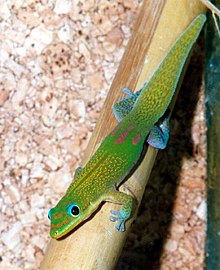Spatulae (biology)
| Gecko Temporal range: 110 Ma – present |
|
|---|---|
 |
|
| Gold dust day gecko | |
| Scientific classification | |
| Kingdom: | Animalia |
| Phylum: | Chordata |
| Class: | Reptilia |
| Order: | Squamata |
| Infraorder: |
Gekkota Cuvier, 1817 |
| Families | |
|
Pygopodidae |
|
Pygopodidae
Carphodactylidae
Diplodactylidae
Eublepharidae
Sphaerodactylidae
Gekkonidae
Phyllodactylidae
Geckos are lizards belonging to the infraorder Gekkota, found in warm climates throughout the world. They range from 1.6 to 60 cm (0.64 to 24 inches). Most geckos cannot blink, but they often lick their eyes to keep them clean and moist. They have a fixed lens within each iris that enlarges in darkness to let in more light.
Geckos are unique among lizards in their vocalizations. They use chirping sounds in social interactions with other geckos. They are the most species-rich group of lizards, with about 1,500 different species worldwide. The New Latin gekko and English "gecko" stem from the Indonesian-Malay gēkoq, which is imitative of the sound the animals make.
All geckos, excluding the Eublepharidae family, lack eyelids and instead have a transparent membrane, which they lick to clean. Nocturnal species have an excellent night vision; their color vision is 350 times more sensitive than human color vision. The nocturnal geckos evolved from diurnal species which had lost the eye rods. The gecko eye therefore modified its cones that increased in size into different types both single and double. Three different photopigments have been retained and are sensitive to UV, blue, and green. They also use a multifocal optical system that allows them to generate a sharp image for at least two different depths.
Most gecko species can lose their tails in defense, a process called autotomy. Many species are well known for their specialised toe pads that enable them to climb smooth and vertical surfaces, and even cross indoor ceilings with ease. Geckos are well-known to people who live in warm regions of the world, where several species of geckos make their home inside human habitations. These (for example the house gecko) become part of the indoor menagerie and are often welcomed, as they feed on insects, including moths and mosquitoes. Unlike most lizards, geckos are usually nocturnal.
...
Wikipedia
